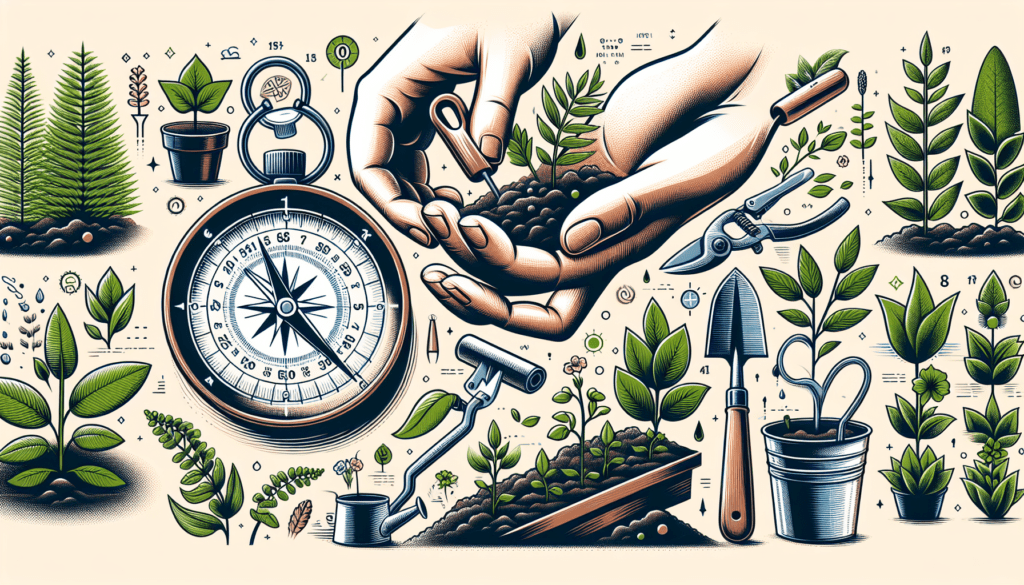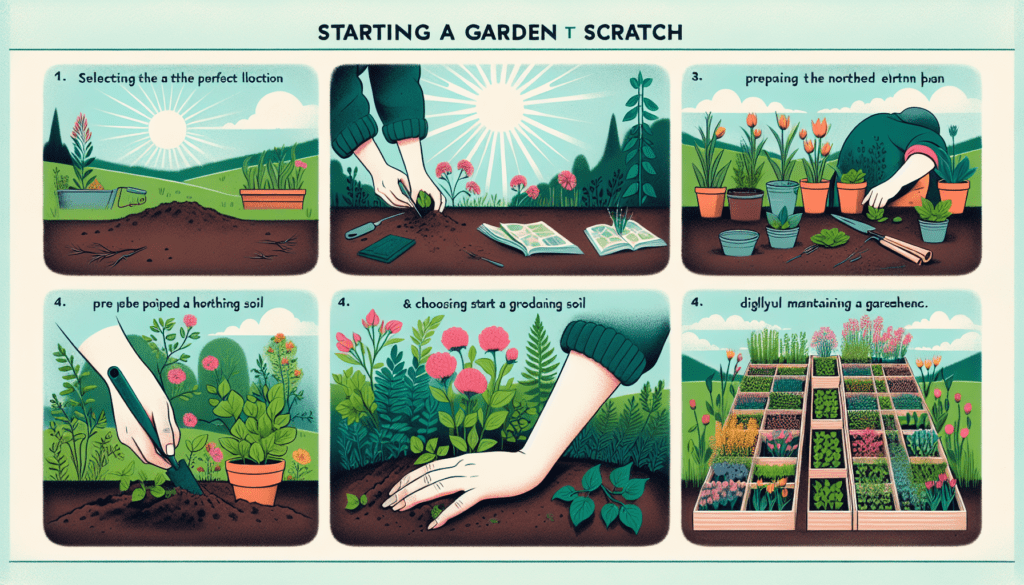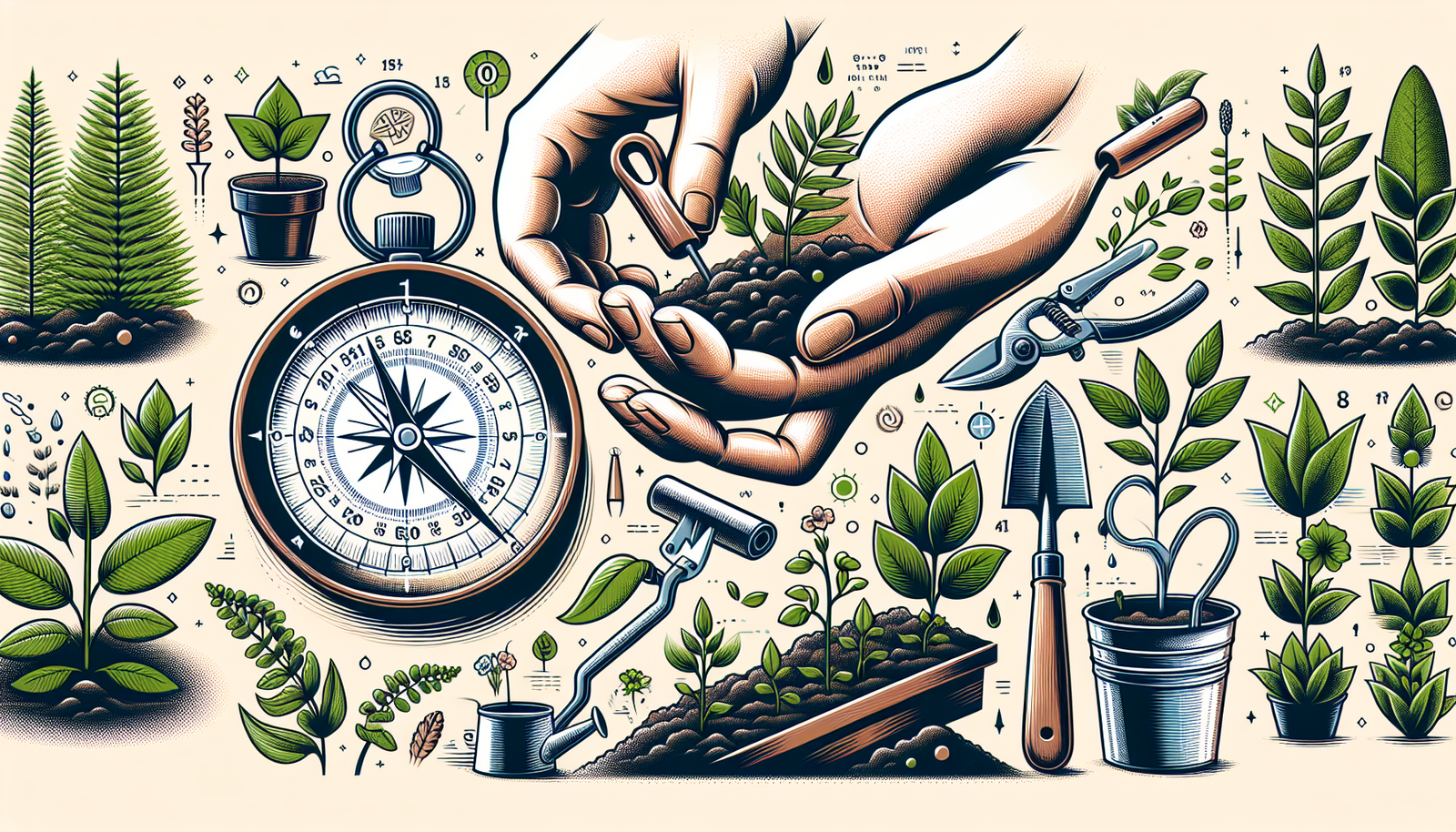Imagine transforming a barren piece of land into a thriving oasis of greenery and vibrant blooms. In this comprehensive step-by-step guide, you will discover all the essential information needed to start your very own garden from scratch. Whether you are a seasoned green thumb or a complete beginner, this article will provide you with the knowledge and confidence to bring life and beauty to your outdoor space. From planning and preparing the soil to selecting the perfect plants for your garden, each step is outlined in a friendly and accessible manner. So grab your gardening gloves and get ready to embark on a fulfilling journey of nurturing plants and creating your own personal sanctuary. Starting a garden from scratch can be a rewarding and fulfilling experience. Whether you’re looking to grow your own vegetables, cultivate a beautiful flower bed, or simply enjoy the benefits of being surrounded by nature, creating a garden is a wonderful way to connect with the outdoors and nurture your green thumb.
Choose the Right Location
When starting a garden, choosing the right location is crucial for the success of your plants. Consider the amount of sunlight and shade that the area receives throughout the day. Most plants require at least six hours of direct sunlight, so it’s important to select a spot that gets adequate sunshine. Additionally, evaluate the soil conditions of the area. Some plants thrive in well-draining soil, while others prefer moist or sandy soil. Understanding the specific needs of your desired plants will help you determine if the location is suitable.
Consider Sunlight and Shade
Sunlight is essential for plant growth, so it’s essential to choose a location that receives ample sunshine. Observe the area at different times of the day to identify how much sunlight it receives. Keep in mind that some areas may be shaded by buildings, trees, or other structures, which can affect the amount of sunlight plants receive. If you’re planning on growing vegetables or fruits, it’s best to choose a spot that gets at least six hours of direct sunlight. However, if you’re interested in growing shade-loving plants, such as ferns or hostas, a partially shaded area may be ideal.
Evaluate Soil Conditions
The quality and composition of the soil in your chosen location can greatly impact the success of your garden. Different plants have varying soil requirements, so it’s essential to evaluate the soil conditions before planting. Conduct a soil test to determine its pH level and nutrient content. Most plants thrive in slightly acidic to neutral soil, with a pH range of 6.0 to 7.5. Depending on the results of your soil test, you may need to amend the soil by adding organic matter, such as compost or well-rotted manure, to improve its fertility and structure.
Plan Your Garden Layout
Once you’ve chosen the right location, it’s time to plan the layout of your garden. This step is crucial for efficient use of space and optimizing plant growth.
Decide on Garden Size
Consider the available space and the amount of time and effort you’re willing to invest in maintaining your garden. If you’re a beginner, starting with a small garden is advisable, as it allows you to manage the plants effectively and learn the necessary gardening techniques. As you gain experience and confidence, you can always expand your garden in the future.
Plot the Design
Sketching a layout of your garden can help you visualize how plants will be arranged and ensure a harmonious design. Take into account factors such as the mature size of each plant, their growth habits, and any specific requirements they may have. Consider grouping plants with similar water and sunlight needs together, allowing for efficient watering and maintenance. Additionally, leave enough space for pathways and access to facilitate plant care and harvesting.

Clear the Area
Before you can start planting, it’s important to clear the designated area of any existing grass, weeds, or debris.
Remove Grass and Weeds
Begin by removing any grass or weeds present in the area to eliminate competition for nutrients and space. This can be done by physically pulling them out by hand, using a garden fork, or utilizing a weed killer if necessary. Ensure that the area is free from any unwanted vegetation for a healthier and more productive garden.
Prepare the Soil
Once the area is cleared, it’s time to prepare the soil for planting. Loosen the soil with a garden fork or tiller to promote better drainage and root penetration. Remove any rocks, roots, or other obstacles that may hinder plant growth. Incorporate organic matter, such as compost or well-rotted manure, into the soil to improve its fertility and structure. This will provide essential nutrients to your plants and create a healthy environment for their roots to flourish.
Create Garden Beds
Creating defined garden beds not only adds aesthetic appeal but also helps in efficient plant management and soil drainage.
Determine Bed Shapes
Decide on the shape and size of your garden beds, taking into account the available space and the desired design. Rectangular or square beds are common choices as they are easier to maintain and maximize space utilization. However, you can also opt for circular or irregularly-shaped beds to add visual interest to your garden. Remember to leave enough space between the beds for pathways and accessibility.
Construct Raised Beds
Raised beds offer several benefits, including improved drainage, better soil quality, and easier accessibility. Constructing raised beds involves building frames or using pre-made raised bed kits. Use rot-resistant materials such as cedar or composite lumber to ensure durability. Fill the raised beds with a mixture of compost, topsoil, and organic matter to provide a nutrient-rich growing environment for your plants.

Choose Your Plants
Selecting the right plants is crucial for a successful garden. Consider factors such as your climate, hardiness zone, and the specific requirements and preferences of the plants you intend to grow.
Consider Climate and Zone
Different plants thrive in different climatic conditions, so it’s important to choose plants that are well-suited to your local climate. Research the climate zone you are in and identify plants that are known to thrive in that specific region. Understanding the average frost dates, rainfall patterns, and temperatures of your area will help you make informed decisions when selecting plants.
Select Suitable Varieties
When choosing plants, consider their growth habits, size, and specific requirements, such as sunlight, water, and soil conditions. Ensure that the plants you choose are suitable for your chosen location and align with your gardening goals. For example, if you have limited space, look for compact or dwarf varieties that won’t overcrowd your garden.
Prepare Seedlings or Seeds
Depending on the type of plants you’ve chosen, you may need to start seedlings indoors or directly plant seeds in pots.
Start Seedlings Indoors
Certain plants such as tomatoes, peppers, and broccoli benefit from an early start indoors before being transplanted into the garden. Sow seeds in seed trays or pots filled with seed-starting mix, ensuring adequate moisture and warmth for germination. Place the trays in a warm and well-lit area, such as a greenhouse or a sunny windowsill. Once the seedlings have grown and the outdoor temperatures are appropriate, they can be carefully transplanted into the garden.
Plant Seeds in Pots
Alternatively, some plants, such as herbs or flowers, can be directly sown in pots. Fill the containers with potting soil, sow the seeds according to the package instructions, and provide the necessary conditions for germination. Keep the soil consistently moist and place the pots in a well-lit area. Once the seedlings have sprouted and grown a few inches tall, they can be transplanted into your garden beds.
Plant Your Garden
With your seedlings or seeds ready, it’s time to plant them in your prepared garden beds.
Prepare Planting Holes
Dig planting holes in the garden beds, ensuring they are deep and wide enough to accommodate the root system of your plants. Follow the spacing recommendations for each plant to ensure they have enough room to grow and receive adequate sunlight and airflow. Gently remove the seedlings from their pots or trays, taking care not to damage the roots, and place them into the prepared holes. Backfill the holes with soil, gently firming it around the base of the plants.
Give Plants Adequate Spacing
Proper plant spacing is essential to prevent overcrowding, promote airflow, and allow each plant to access sunlight and nutrients effectively. Refer to the plant labels or seed packets for specific spacing instructions, as this can vary depending on the variety. Providing adequate spacing ensures that each plant has room to grow to its full potential and reduces the risk of disease and pest infestations.
Water and Mulch
Watering and mulching are vital practices that help maintain optimal soil moisture levels and promote plant health.
Establish a Watering Routine
Regular watering is essential, especially during the early stages of plant development. Water deeply and thoroughly, ensuring that the moisture reaches the plant’s root zone. It’s important to establish a watering routine that suits your plants’ needs and the specific requirements of your garden. Avoid overwatering, as this can lead to root rot and other diseases. Monitor the moisture levels of the soil and adjust your watering schedule accordingly, taking into account factors such as rainfall and temperature.
Apply Mulch to Conserve Moisture
Mulching is a beneficial practice that helps conserve soil moisture, suppress weed growth, and regulate soil temperature. Spread a layer of organic mulch, such as wood chips, straw, or shredded leaves, around the base of your plants. This will help retain moisture and reduce the need for frequent watering. Additionally, mulch acts as a natural weed barrier, minimizing competition for nutrients and reducing the amount of time spent on weeding.
Provide Support and Protection
Supporting and protecting your plants ensure their stability, healthy growth, and protection against potential threats.
Install Plant Supports
Certain plants, such as tomatoes, peppers, or climbing vines, may require additional support to prevent them from toppling over or breaking under their own weight. Install stakes, trellises, or cages to provide structured support for these plants. Make sure the supports are installed firmly in the ground and secure the plants to them as they grow. Regularly check and adjust the supports as needed throughout the growing season.
Protect Plants from Pests and Weather
Garden pests and unpredictable weather conditions can pose significant challenges to your plants’ health and overall productivity. Implement preventive measures such as installing physical barriers, using natural deterrents, or introducing beneficial insects to control pest populations. Additionally, monitor weather forecasts and take necessary steps to protect your plants from extreme temperatures, strong winds, or heavy rainfall. Covering delicate plants with cloths or providing temporary shelters can help mitigate potential damage.
Enjoy the Fruits of Your Labor
After weeks or months of nurturing and caring for your garden, it’s time to reap the rewards.
Harvest Vegetables and Fruits
As your plants reach maturity, you’ll start to enjoy the bountiful harvest of fresh vegetables, fruits, and herbs. Harvest your crops when they are ripe, following the specific guidelines for each plant. For vegetables, such as tomatoes or cucumbers, harvest when they are fully colored and firm. For herbs, pick leaves or stems as needed, ensuring you leave enough for the plant to continue growing.
Reap the Benefits of a Blooming Garden
Beyond the tangible rewards of fruits and vegetables, a blooming garden brings immeasurable joy and tranquility. Take the time to appreciate the beauty and fragrance of your flowers, the mesmerizing dance of butterflies and bees, and the sense of accomplishment that comes with nurturing nature. Share the joys of your garden with family and friends, and continue learning and experimenting to enhance your gardening skills further.
Starting a garden from scratch may seem intimidating, but by following these step-by-step guidelines, you’ll be well-prepared to create a thriving and fruitful garden. Remember to choose the right location, plan your garden layout, clear the area, create garden beds, choose suitable plants, prepare seedlings or seeds, and plant your garden with care. Maintain proper watering and mulching practices, provide support and protection as needed, and relish in the rewards of your labor. Happy gardening!

